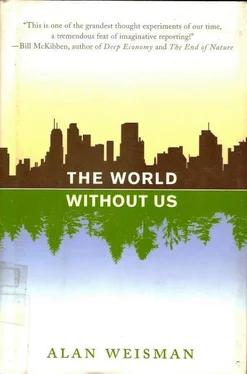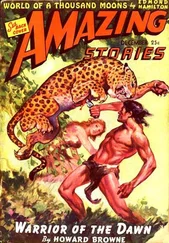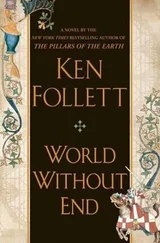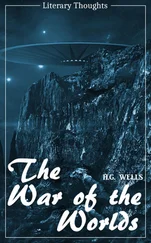This was true. Jefferson, a passionate naturalist, had been enthralled for years by reports of huge bones strewn around a salt lick in the Kentucky wilderness. Descriptions suggested that they were similar to remains discovered in Siberia of a species of giant elephant, thought by European scientists to be extinct. African slaves had recognized big molars found in the Carolinas as belonging to some kind of elephant, and Jefferson was sure these were the same. In 1796 he received a shipment, supposedly of mammoth bones, from Greenbriar County, Virginia, but a huge claw immediately alerted him that this was something else, possibly some immense breed of lion. Consulting anatomists, he eventually identified it and is credited for the first description of a North America ground sloth, today named Megalonyx jefersoni.
Most exciting to him, though, were testimonies by Indians near the Kentucky salt lick, allegedly corroborated by other tribes farther west, that the tusked behemoth in question still lived in the north. After he became president, he sent Meriwether Lewis to study the Kentucky site on the way to joining William Clark for their historic mission. Jefferson had charged Lewis and Clark not only with traversing the Louisiana Purchase and seeking a northwest river route to the Pacific, but also with finding live mammoths, mastodons, or anything similarly large and unusual.
That part of their otherwise stunning expedition proved a failure; the most impressive big mammal they cited was the bighorn sheep. Jefferson later contented himself with sending Clark back to Kentucky for the mammoth bones that he displayed in the White House, today part of museum collections in the United States and France. He is often credited with founding the science of paleontology, though it was not really his intention. He’d hoped to belie an opinion, espoused by a prominent French scientist, that everything in the New World was inferior to the Old, including its wildlife.
He was also fundamentally mistaken about the meaning of fossil bones: he was convinced that they must belong to a living species, because he didn’t believe that anything ever went extinct. Although often considered America’s quintessential Age of Enlightenment intellectual, Jefferson’s beliefs corresponded to those held by many Deists and Christians of his day: that in a perfect Creation, nothing created was ever intended to disappear.
He articulated this credo, however, as a naturalist: “Such is the economy of nature that no instance can be produced of her having permitted any one race of her animals to become extinct.” It was a wish that imbued many of his writings: he wanted these animals to be alive, wanted to know them. His quest for knowledge led him to found the University of Virginia. Over the next two centuries, paleontologists there and elsewhere would show that many species had in fact died. Charles Darwin would describe how these extinctions were part of nature itself—one variety morphing into the next to meet changing conditions, another losing its niche to a more powerful competitor.
Yet one detail that nagged at Thomas Jefferson and others after him was that the big-mammal remains turning up didn’t seem all that old. These weren’t heavily mineralized fossils embedded in solid layers of rock. Tusks, teeth, and jawbones at places like Kentucky’s Big Bone Lick were still strewn on the ground, or protruding from shallow silt, or on the floor of caves. The big mammals they belonged to couldn’t have been gone that long. What had happened to them?
The Desert Laboratory—originally the Carnegie Desert Botanical Laboratory—was built more than a century ago on Tumamoc Hill, a butte in southern Arizona overlooking what was then one of North America’s finest stands of cactus forest and, beyond that, Tucson. For nearly half the lab’s existence, a tall, broad-shouldered, affable paleoecologist named Paul Martin has been here. During that time the desert below Tumamoc’s saguaro-covered slopes disappeared under a snarl of dwellings and commerce. Today, the Lab’s fine old stone structures occupy what developers now covet as prime view property, which they continually scheme to wrest from its present owner, the University of Arizona. Yet when Paul Martin leans on his cane to gaze out his lab’s screened doorway, his frame of reference for human impact is not merely the past century, but the last 13,000 years—since people came to stay.
In 1956, a year before arriving here, Paul Martin had spent the winter in a Quebec farmhouse, during a postdoctoral fellowship at the University of Montreal. A case of polio contracted while collecting bird specimens in Mexico as a zoology undergraduate had rerouted his research from the field to the laboratory. Holed up in Canada with a microscope, he studied sediment cores from New England lakes that dated back to the end of the last ice age. The samples revealed how, as the climate softened, surrounding vegetation changed from treeless tundra to conifers to temperate deciduous—a progression some suspected led to mastodon extinction.
One snowbound weekend, weary of counting tiny grains of pollen, he opened a taxonomy text and started tallying the number of mammals that had disappeared in North America over the past 65 million years. When he reached the final three millennia of the Pleistocene epoch, which lasted from 1.8 million until 10,000 years ago, he started to notice something odd.
During the time frame that coincided with his sediment samples, starting about 13,000 years ago, an explosion of extinctions had occurred. By the beginning of the next epoch—the Holocene, which continues today—nearly 40 species had disappeared, all of them large terrestrial mammals. Mice, rats, shrews, and other small fur-bearing creatures had emerged unscathed, as had marine mammals. Terrestrial megafauna, however, had taken an enormous, lethal wallop.
Among the missing were a legion of animal kingdom Goliaths: giant armadillos and the even-bigger glyptodonts, resembling armor-plated Volkswagens, with tails that ended in spiked maces. There were giant short-faced bears, nearly double the size of grizzlies and, with extra long limbs, much faster—one theory suggests that giant short-faced bears in Alaska were why Siberian humans hadn’t crossed the Bering Strait much earlier. Giant beavers, as big as today’s black bears. Giant peccaries, which may have been prey to Panthern leo atrox, the American lion that was considerably bigger and swifter than today’s surviving African species. Likewise, the dire wolf, the largest of canines, with a massive set of fangs.
The best-known extinct colossus, the northern woolly mammoth, was only one of many kinds of Proboscidea, including the imperial mammoth, largest of all at 10 tons; the hairless Columbian mammoth, which lived in warmer regions; and, in California’s Channel Islands, a dwarf mammoth no taller than a human—only the collie-sized elephants on Mediterranean islands were smaller. Mammoths were grazing animals, evolved to steppes, grassland, and tundra, unlike their much older relatives, the mastodons, which browsed in woods and forests. Mastodons had been around for 30 million years, and ranged from Mexico to Alaska to Florida—but suddenly they, too, were gone. Three genera of American horses: gone. Multiple varieties of North American camels, tapirs, numerous antlered creatures ranging from dainty pronghorns to the stag moose, which resembled a cross between a moose and an elk but was larger than either, all gone, along with the saber-toothed tiger and the American cheetah (the reason why the sole remaining pronghorn species of antelope is so fleet). All gone. And all pretty much at once. What, Paul Martin wondered, could possibly have caused that?
The following year, he was on Tumamoc Hill, his big frame again perched over a microscope. This time, rather than pollen grains saved from decay by an airtight covering of lake-bottom silt, he was viewing magnified fragments preserved in a moisture-free Grand Canyon cave. Soon after he arrived in Tucson, his new boss at the Desert Lab had handed him an earthen gray lump the approximate size and shape of a softball. It was at least 10,000 years old, but unmistakably a turd. Mummified but not mineralized, it yielded identifiable fibers of grasses and flowering globe mallow. The plentiful juniper pollen Martin found confirmed his subject’s great age: temperatures near the floor of the Grand Canyon have not been cool enough to sustain juniper for eight millennia.
Читать дальше











